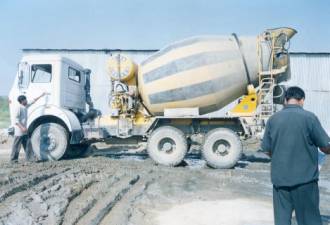Properties of hardened concrete
Tests are conducted
on hardened concrete to estimate properties like, compressive
strength, tensile strength, modulus of rupture, elastic
modulus, Poisson's ratio, creep and shrinkage performance,
durability, thermal expansion coefficient etc.
These parameters are of functions of aggregate type,
shape and size, type and quantity of cement and admixtures
incorporated, water cement ratio, curing, age etc.
Compressive strength of concrete is the failure compressive stress on cubical or cylindrical samples of concrete. Compressive strength of concrete is related to the combined effect of temperature and time, a parameter called maturity. Maturity of concrete is calculated as the time of curing (in hours), multiplied by the temperature, (in degrees) above some specified reference temperature. Various empirical relationships are suggested to obtain the various strength parameters of concrete (elastic modulus, tensile strength, bending strength etc.) from the compressive strength of concrete.
Direct tension test on concrete is performed by applying tension to the cylindrical or dumble shaped samples of concrete. Indirect tension is applied to concrete samples by split cylinder test.
Modulus of rupture of concrete is
estimated by measuring the maximum bending stress
on concrete beam subjected to pure bending in static
condition.
Fatigue test is generally performed subjecting the concrete beams with repetitive flexural loading. The more is the stress ratio (defined as the ratio between the bending stress applied to the modulus of rupture) the less is the fatigue life. The empirically derived fatigue equation by PCA (1974) is the following:
 |
(1) |
and
 |
(2) |
Where, Nf is the number of load applications to failure,
SR is the stress ratio with reference to 90 days modulus of rupture.
The equation suggested by AASHTO
(1993) is the following:
 |
(3) |
Transportation of concrete
The transportation
of concrete is to be done in such a way that
segregation and premature setting is avoided. Wheel
barrow, truck mixer, dumper truck, belt conveyor,
pipe-line etc.
are the various ways concrete is transported
to the construction site. Figure 4 shows a typical
truck concrete mixer.

Figure 4: A typical truck concrete mixer
|